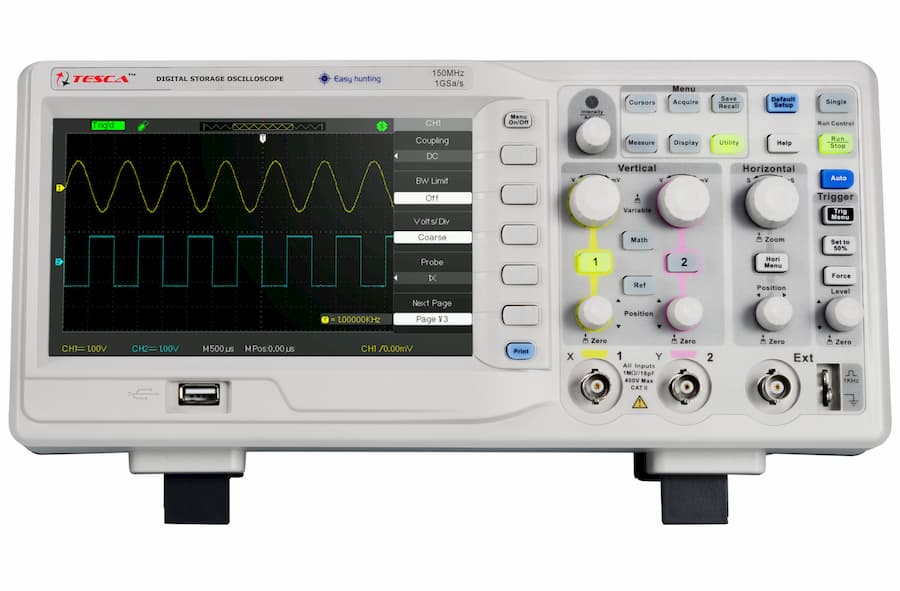An oscilloscope is a laboratory instrument commonly used to display and analyze the waveform of electronic signals. In effect, the device draws a graph of the instantaneous signal voltage as a function of time. Typically oscilloscope can display alternating current or pulsating direct current waveforms having a frequency as low as approximately 1 Hz or as high as several MHz. High-end oscilloscopes can display signals having frequencies up to several hundred gigahertz (GHz).
Oscilloscopes are used for many measurements including:
- Voltage Measurements
- Time and Frequency Measurements
- Pulse Width and Rise Time Measurements
- Phase Shift Measurements
The display is broken up into so-called horizontal and vertical divisions. Time is displayed from left to right on the horizontal scale. Instantaneous voltage appears on the vertical scale, with positive values going upward and negative values going downward.
The older form of the oscilloscope, still used in some labs today, is known as the cathode-ray oscilloscope (CRO). It produces an image by causing a focused electron beam to travel, or sweep, in patterns across the face of a cathode ray tube (CRT). More modern oscilloscopes electronically replicate the action of the CRT using a liquid crystal display (liquid crystal display) similar to those found on notebook computers. Modern oscilloscopes employ computers to process and display waveforms. These computers can use any type of display, including CRT, LCD, and gas plasma.
Nowadays, high-end digital oscilloscopes can be connected to personal computers and use their displays. Although these machines no longer employ scanning electron beams to generate images of waveforms in the manner of the old cathode-ray “scope,” the basic principle is the same. Software controls the sweep rate, vertical deflection, and a host of other features which can include:
- Storage of waveforms for future reference and comparison
- Display of several waveforms simultaneously
- Spectral analysis
- Portability
- Battery power option
- Usability with all popular operating platforms
- Zoom-in and zoom-out
- Multi-colour displays
Modern digital oscilloscopes fall into the categories of digital storage oscilloscopes (DSO), digital phosphor oscilloscopes (DPO), and sampling oscilloscopes.
All three have vertical, horizontal, acquisition, and triggering systems.
A basic oscilloscope consists of three different systems – the vertical system, horizontal system, and trigger system. Each system contributes to the oscilloscope’s ability to accurately reconstruct a signal. The front panel of an oscilloscope is divided into three sections labelled Vertical, Horizontal, and Trigger. Your oscilloscope may have other sections, depending on the model and type. When using an oscilloscope, one has to adjust settings in these areas to accommodate an incoming signal:
- Vertical: This is the attenuation or amplification of the signal. Use the volts/div control to adjust the amplitude of the signal to the desired measurement range.
- Horizontal: This is the time base. Use the sec/div control to set the amount of time per division represented horizontally across the screen.
- Trigger: This is the triggering of the oscilloscope. Use the trigger level to stabilize a repeating signal, or to trigger on a single event.
Apart from these oscilloscopes may have other controls for various functions such as:
- Automatic parametric measurements
- Measurement cursors
- Keypads for mathematical operations or data entry
- Printing capabilities
- Interfaces for connecting your oscilloscope to a computer or directly to the Internet
The oscilloscope is used for electronics measurements, particularly for waveform measurements on analog circuits. The principle is that a CRT beam is deflected horizontally by a sawtooth waveform, the timebase, while the vertical deflection is caused by an input signal. If the timebase speed is correctly matched to the frequency of the incoming waveform, one or more cycles of the wave will be displayed, and a measuring graticule allows voltage and time measurements to be carried out.
Moreover, the oscilloscope is one of the most widely used test instruments; its commercial, engineering, and scientific applications include acoustic research, television-production engineering, and electronics design.




